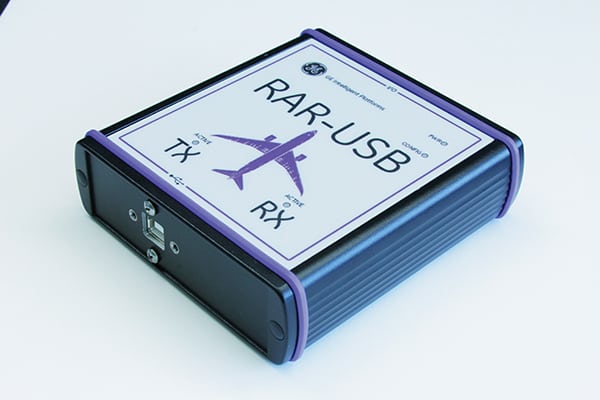Global Avionics Round-Up from Aircraft Value News (AVN)

The intelligent high density GE RAR-USB ARINC 429 USB Adapter
In the world of avionics, where cutting-edge technology powers navigation, communication, and flight control systems, it might come as a surprise that one of the most widely used cockpit technologies, the ARINC 429 data bus, traces its origins to the 1970s and is increasingly anachronistic.
The ARINC 429 was designed about 50 years ago as a reliable means to transfer data between avionics systems in commercial aircraft. Despite its venerable age, this protocol remains the backbone for data communication in many airliners, business jets, and even military aircraft.
The stubborn persistence of ARINC 429 poses critical challenges to the aviation industry, affecting safety, efficiency, and modernization efforts.
Even after five decades, the ARINC 429 data bus protocol is considered as an important data bus standard given it is used in the avionics systems of the B737, B747, B767, A320, A340, and MD-11 aircraft.
Understanding why this technology remains entrenched, the problems it causes, and how the industry is addressing the issue sheds light on a deeper tension between innovation and legacy in avionics.
ARINC 429’s fundamental design is simplicity itself. It is a unidirectional, point-to-point serial data bus where one transmitter communicates with multiple receivers via a single twisted pair of wires. Its modest data rate, fixed at either 12.5 or 100 kilobits per second, reflects the technological constraints and performance needs of the era in which it was created.
This slow speed sufficed for transmitting relatively low-bandwidth data such as flight instrument readings, autopilot commands, and sensor outputs. The standardized 32-bit word format ensured compatibility across avionics manufacturers and facilitated straightforward troubleshooting.
Strengths Become Liabilities
However, the very strengths that made ARINC 429 revolutionary in the 1970s are its greatest liabilities today. The protocol’s inherent limitations stem from its low bandwidth, lack of full duplex communication, and point-to-point wiring architecture.
Modern avionics systems are exponentially more complex and data hungry, demanding real-time high-speed data exchange among multiple subsystems. ARINC 429’s fixed, slow speed and unidirectional flow mean that avionics suites must rely on multiple parallel wires and redundant channels, creating enormous wiring harnesses that add weight, complexity, and maintenance headaches. The physical bulk of these cable runs also constrains aircraft design, reducing available space and increasing manufacturing costs.
Moreover, ARINC 429’s architecture limits the ability to implement advanced fault-tolerant communication methods and error detection. With no support for multi-node communication or dynamic network reconfiguration, diagnosing faults and re-routing data paths is difficult, if not impossible. This undermines safety margins and adds to the logistical challenges of maintaining aircraft, especially as fleets age and system reliability becomes paramount.
The inefficiencies of ARINC 429 also impede the integration of newer avionics technologies, such as real-time sensor fusion, predictive maintenance diagnostics, and increasingly common software-defined avionics systems that thrive on flexible, high-throughput data networks.
Yet, replacing ARINC 429 wholesale is far easier said than done. The aviation industry is famously conservative when it comes to certifying new systems due to the immense safety stakes involved. Every component of an avionics suite must undergo rigorous testing, certification, and integration validation that can take years and cost millions of dollars.
Since ARINC 429 hardware and interfaces are deeply embedded in the architecture of countless existing aircraft — from legacy Boeing and Airbus models to business jets and military transports — retrofitting or redesigning these systems involves massive logistical, technical, and regulatory hurdles.
Gradual Evolution
The industry is addressing the ARINC 429 problem primarily through gradual evolution rather than revolution. One of the most significant steps has been the adoption of newer data bus standards such as ARINC 664, better known as the Avionics Full-Duplex Switched Ethernet (AFDX) protocol.
AFDX supports gigabit Ethernet speeds, full duplex communication, and deterministic data delivery, enabling avionics systems to communicate on a shared network rather than fixed point-to-point links. This significantly reduces wiring complexity, increases bandwidth availability, and allows for more robust fault tolerance and network management.
AFDX is already the foundation for avionics data communication on modern aircraft like the A350 and B787, which incorporate “fly-by-wire” controls, integrated modular avionics, and sophisticated sensor fusion architectures that would be impossible to support efficiently with ARINC 429.
However, AFDX’s transition has been slow and incremental. Legacy aircraft continue to operate with ARINC 429 buses due to the prohibitive cost of retrofits and the complexity of certifying mixed-technology systems. Hybrid solutions often combine legacy ARINC 429 hardware with gateway devices that translate between the old and new protocols, easing integration without full system replacement.
This article originally appeared in our partner publication, Aircraft Value News.
John Persinos is the editor-in-chief of Aircraft Value News.